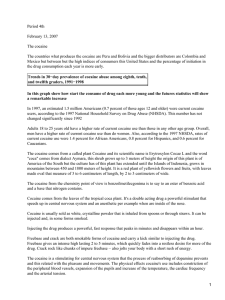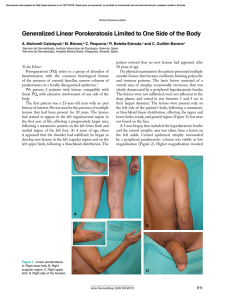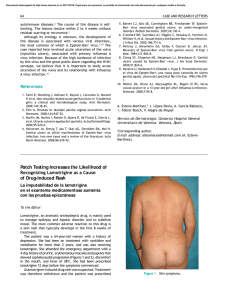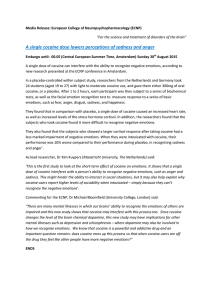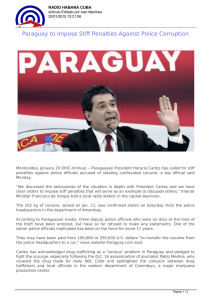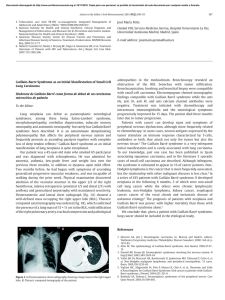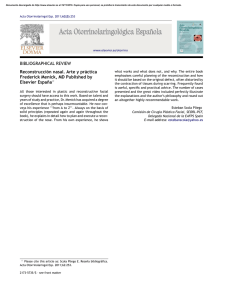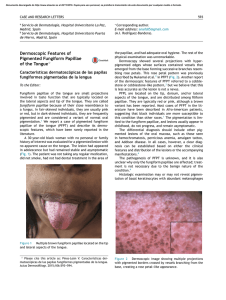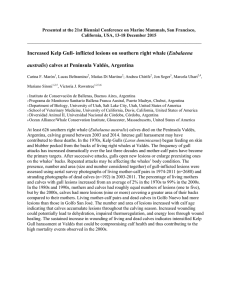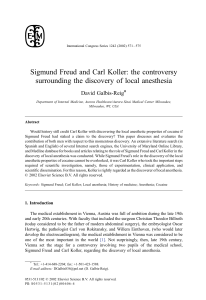Two Cases of Eruptive Pyoderma Gangrenosum Associated with
Anuncio
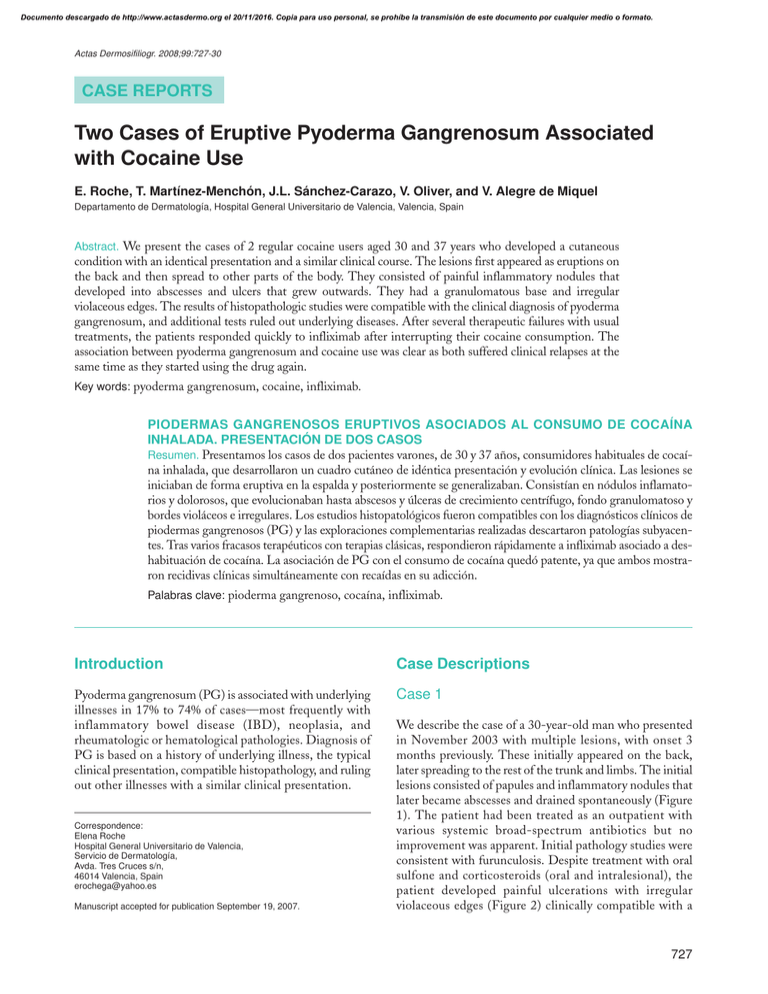
Documento descargado de http://www.actasdermo.org el 20/11/2016. Copia para uso personal, se prohíbe la transmisión de este documento por cualquier medio o formato. Actas Dermosifiliogr. 2008;99:727-30 CASE REPORTS Two Cases of Eruptive Pyoderma Gangrenosum Associated with Cocaine Use E. Roche, T. Martínez-Menchón, J.L. Sánchez-Carazo, V. Oliver, and V. Alegre de Miquel Departamento de Dermatología, Hospital General Universitario de Valencia, Valencia, Spain Abstract. We present the cases of 2 regular cocaine users aged 30 and 37 years who developed a cutaneous condition with an identical presentation and a similar clinical course. The lesions first appeared as eruptions on the back and then spread to other parts of the body. They consisted of painful inflammatory nodules that developed into abscesses and ulcers that grew outwards. They had a granulomatous base and irregular violaceous edges. The results of histopathologic studies were compatible with the clinical diagnosis of pyoderma gangrenosum, and additional tests ruled out underlying diseases. After several therapeutic failures with usual treatments, the patients responded quickly to infliximab after interrupting their cocaine consumption. The association between pyoderma gangrenosum and cocaine use was clear as both suffered clinical relapses at the same time as they started using the drug again. Key words: pyoderma gangrenosum, cocaine, infliximab. PIODERMAS GANGRENOSOS ERUPTIVOS ASOCIADOS AL CONSUMO DE COCAÍNA INHALADA. PRESENTACIÓN DE DOS CASOS Resumen. Presentamos los casos de dos pacientes varones, de 30 y 37 años, consumidores habituales de cocaína inhalada, que desarrollaron un cuadro cutáneo de idéntica presentación y evolución clínica. Las lesiones se iniciaban de forma eruptiva en la espalda y posteriormente se generalizaban. Consistían en nódulos inflamatorios y dolorosos, que evolucionaban hasta abscesos y úlceras de crecimiento centrífugo, fondo granulomatoso y bordes violáceos e irregulares. Los estudios histopatológicos fueron compatibles con los diagnósticos clínicos de piodermas gangrenosos (PG) y las exploraciones complementarias realizadas descartaron patologías subyacentes. Tras varios fracasos terapéuticos con terapias clásicas, respondieron rápidamente a infliximab asociado a deshabituación de cocaína. La asociación de PG con el consumo de cocaína quedó patente, ya que ambos mostraron recidivas clínicas simultáneamente con recaídas en su adicción. Palabras clave: pioderma gangrenoso, cocaína, infliximab. Introduction Case Descriptions Pyoderma gangrenosum (PG) is associated with underlying illnesses in 17% to 74% of cases—most frequently with inflammatory bowel disease (IBD), neoplasia, and rheumatologic or hematological pathologies. Diagnosis of PG is based on a history of underlying illness, the typical clinical presentation, compatible histopathology, and ruling out other illnesses with a similar clinical presentation. Case 1 Correspondence: Elena Roche Hospital General Universitario de Valencia, Servicio de Dermatología, Avda. Tres Cruces s/n, 46014 Valencia, Spain erochega@yahoo.es Manuscript accepted for publication September 19, 2007. We describe the case of a 30-year-old man who presented in November 2003 with multiple lesions, with onset 3 months previously. These initially appeared on the back, later spreading to the rest of the trunk and limbs. The initial lesions consisted of papules and inflammatory nodules that later became abscesses and drained spontaneously (Figure 1). The patient had been treated as an outpatient with various systemic broad-spectrum antibiotics but no improvement was apparent. Initial pathology studies were consistent with furunculosis. Despite treatment with oral sulfone and corticosteroids (oral and intralesional), the patient developed painful ulcerations with irregular violaceous edges (Figure 2) clinically compatible with a 727 Documento descargado de http://www.actasdermo.org el 20/11/2016. Copia para uso personal, se prohíbe la transmisión de este documento por cualquier medio o formato. Roche E et al. Two Cases of Eruptive Pyoderma Gangrenosum Associated with Cocaine Use Figure 1. Case 1. Initial outbreak of suppurative nodular lesions on the back. Figure 2. Case 1. Lesions on the legs developing toward ulcers with irregular base and violaceous edges. diagnosis of PG. A new biopsy showed a necrotic and ulcerated epidermis, with pseudoepitheliomatous hyperplasia on the edges of the ulcer. Edema was apparent in the dermis, along with a dense infiltrate of neutrophils, lymphocytes, and macrophages (Figure 3), with hemorrhagic areas, edema, and hyalinization of the capillary endothelia. Disease progression and pathology finally indicated a diagnosis of multiple PG. The patient had no systemic symptoms and tests undertaken to rule out diseases commonly associated with PG proved normal: blood tests (blood count, biochemistry, protein profile, autoantibodies, Sézary cell count, T-cell populations, coagulation, serology for human immunodeficiency virus (HIV), hepatitis C virus, and hepatitis B virus), gastric endoscopy, opaque enema, and bone marrow aspiration. Treatments with oral cyclosporin (5 mg/kg/d), oral methotrexate (15 mg/wk), and topical tacrolimus were unsuccessful. Later disease progression was atypical, with constant recurrence, general progressive deterioration, and the development of painful ulcers on the legs measuring more than 15 cm across. Finally, whole body computed tomography was performed in the search for an underlying disease. The scan revealed a perforation in the nasal septum and enlarged lateral cervical lymph nodes. The patient admitted to sniffing cocaine over the last 2 years. Following the failure of conventional therapies, treatment with infliximab 5 mg/kg was prescribed in weeks, 0, 2, 6, and then every 8 weeks for a year, with associated oral methotrexate 15 mg/wk. The patient was also referred to addiction support services for rehabilitation. A great improvement was seen in the first month and a half, and the lesions had healed by the end of the year in spite of later recurrences coinciding with positive results for cocaine in the urine. Further recurrence occurred after treatment was suspended and 3 months of treatment with etanercept 50 mg/wk made no improvement. Infliximab was prescribed again, but despite improvements during the first 2 months, subsequent complete response was not achieved. Recurrences at the end of each cycle resulted in the drug being administered every 6 weeks. Later relapses in drug use were associated with a worsening of symptoms that were managed with regular injections of corticosteroids. Case 2 Figure 3. Case 1. Skin edema and predominantly neutrophilic diffuse inflammatory infiltrate. Hematoxylin-eosin ×20. 728 The patient was a 30-year-old man who consulted in July 2005. He presented numerous lesions on the back, the upper third of his arms, and a single lesion on the right cheek with onset 4 months previously (Figure 4). These began as inflammatory papules that developed into suppurating nodules and painful exudative ulcers with an irregular granular base and raised violaceous edges. The lesions had been treated with oral antibiotics with no Actas Dermosifiliogr. 2008;99:727-30 Documento descargado de http://www.actasdermo.org el 20/11/2016. Copia para uso personal, se prohíbe la transmisión de este documento por cualquier medio o formato. Roche E et al. Two Cases of Eruptive Pyoderma Gangrenosum Associated with Cocaine Use improvement and the patient presented no systemic symptoms. Given the clinical similarity to the previous case, in terms of epidemiology, the distribution of lesions, and disease progression, the patient was asked about drug consumption. He admitted sniffing cocaine daily over the last 10 years. A biopsy was taken, and the pathology study was compatible with a diagnosis of PG. The epidermis showed intraepithelial microabscesses comprised of neutrophils and areas of epidermal necrosis. A dense and diffuse inflammatory infiltrate was seen in the dermis, composed of neutrophils, eosinophils, lymphocytes and macrophages, edema, and extravasated red blood cells. The capillary vessel walls presented edema with fibrinoid deposition. Tests were performed (complete blood count, renal profile, liver and thyroid function, autoantibodies, protein profile, serology for hepatitis viruses and HIV ), Mantoux intradermal test, chest x-ray, and colonoscopy, all with normal or negative results. Following the failure of conventional therapies and the improvement obtained with infliximab associated with abstinence from cocaine in the previous case, this treatment was chosen as the first alternative, with the addition of topical tacrolimus. There was a rapid reduction in the size of the lesions and suppuration during the first 8 weeks, with progressive epithelialization (Figure 5) and reduced pain. During the unplanned admissions of the patient to hospital, urine tests were taken and the patient was monitored by addiction support services. The patient presented recurrence of lesions at the end of each cycle of treatment, and so the interval between treatments was reduced to 6 weeks. Figure 4. ase 2. Initial outbreak of suppurative nodular lesions on the back. Observe the similarity with Case 1. Discussion Most patients (>70%) with ulcerative PG present underlying illnesses like IBD, arthritis, monoclonal gammopathy, or internal neoplasia. PG vegetans is the only form of the disease that tends not to be associated with systemic diseases, but this is characterized by slow-growing painless lesions with more superficial ulceration and less violaceous edges that are not usually purulent.1 Disease progression in our patients is similar to the type of ulcerative PG predominant in the lower limbs. However, in our cases the lesions began with multiple eruptions on the back, later extending to the limbs and, in addition, lacking the associated systemic symptoms. Certain drugs like sulpiride2 and hematopoietic growth factors can trigger eruptions similar to PG, but no relationship has yet been reported between drug abuse and PG. Visceral ischemia is commonly associated with cocaine consumption. Endothelial damage can be due to the direct Figure 5. back. Case 2. Residual marbled pigmentation on the toxic effect, or as a consequence of prolonged vasoconstriction.3 Street cocaine contains impurities used as fillers (for example: quinine, sugar, procaine, and amphetamines) which may also produce distal vascular obstruction or inflammatory reactions.4 There is a broad spectrum of skin lesions produced by various forms of cocaine use (intravenous and subcutaneous injection, and sniffing); they are generally distal and range from simple digital vasospasm and Raynaud syndrome5 to small and medium vessel vasculitis with purpura, urticaria vasculitis,6 ulceration, necrotic livedo,7 and gangrene.8 The Actas Dermosifiliogr. 2008;99:727-30 729 Documento descargado de http://www.actasdermo.org el 20/11/2016. Copia para uso personal, se prohíbe la transmisión de este documento por cualquier medio o formato. Roche E et al. Two Cases of Eruptive Pyoderma Gangrenosum Associated with Cocaine Use most serious cases occur when there is intravenous cocaine use and are accompanied by systemic symptoms of fever and visceral toxicity. Direct administration via the skin causes localized necrosis.9 Bullous erythema multiforme lesions have also been described,10 as have infectious bacterial or mycotic complications. The potent vasoconstrictor effect of sniffed cocaine can produce ischemic necrosis with perforation of the nasal septum, which should be differentiated from other destructive lesions of the midline like Wegener granulomatosis. Two cases have been published of PG complicated by nasal perforation, where examinations found no suggestion of Wegener granulomatosis, and the authors concluded the septal perforation was secondary to mucosal involvement of PG.11 Although the epidemiological characteristics of the progression of the lesions do not agree with those described in our patients, they did not rule out cocaine consumption. The most effective treatments according to the literature are corticosteroids and cyclosporin and both are considered first line drugs. Infliximab can be considered a first line therapy in this group due to its rapid effectiveness in IBDassociated PG.12 However, it has also been effective in many cases of PG not associated with IBD.13,14 Just as in our cases, rapid improvements are seen in the first month, although minor recurrences in some patients after the tenth week of injections can lead to intervals between infusions being shortened to 6 weeks.15 The combination of infliximab and other immunosuppressants can help maintain effectiveness and extend the duration of remission once treatment has ended. Finally, while it has been shown that cocaine can produce ischemic skin disorders, our patients are the first reported cases of PG secondary to cocaine use. Our experience clearly demonstrates the effectiveness of treatment with infliximab associated with abstinence from cocaine use. Conflicts of Interest The authors declare no conflicts of interest. 730 References 1. Ahmadi S, Powell FC. Pyoderma gangrenosum: uncommon presentations. Clin Dermatol. 2005;23:612-20. 2. Srebrnik A, Shachar E, Brenner S. Suspected induction of a pyoderma gangrenosum-like eruption due to sulpiride treatment. Cutis. 2001;67:253-6. 3. Heng MCY, Haberfeld G. Thrombotic phenomena associated with intravenous cocaine. J Am Acad Dermatol. 1987;16: 462-8. 4. Del Giudice P. Cutaneous complications of intravenous drug abuse. Br J Dermatol. 2004;150:1-10. 5. Trozak DJ, Gould WM. Cocaine abuse and connective tissue disease. J Am Acad Dermatol. 1984;10:525. 6. Hofbauer GF, Hafner J, Trueb RM. Urticarial vasculitis following cocaine use. Br J Dermatol. 1999;600-1. 7. Jouary T, Bens G, Lepreux S, Buzenet C, Taieb A. Livedo nécrotique localise après injection de cocaïne. Ann Dermatol Venereol. 2003;130:537-40. 8. Gutiérrez A, England JD, Krupski WC. Cocaine induced peripheral vascular occlusive disease, a case report. Angiology. 1998;49:221-4. 9. Mouraviev VB, Pautler SE, Hayman WP. Fournier’s gangrene following penile self-injection with cocaine. Scand J Urol Nephrol. 2002;36:317-8. 10. Tomecki KJ, Wikas SM. Cocaine-related bullous disease. J Am Acad Dermatol. 1985;12:585-6. 11. Matsumura T, Sato-Matsumura KC, Ota M, Yokota T, Arita K, Kodama D, et al. Two cases of pyoderma gangrenosum complicated with nasal septal perforation. Br J Dermatol. 1999;141:1133-5. 12. Reichrath J, Bens G, Bonowitz A, Tilgen W. Treatment recommendations for pyoderma gangrenosum: an evidencebased review of the literature based on more than 350 patients. J Am Acad Dermatol. 2005;53:273-83. 13. Jenne L, Sauter B, Thumann P, Hertl M, Schuler G. Successul treatment of therapy-resistant chronic vegetating pyoderma gangrenosum with infliximab. Br J Dermatol. 2004; 150:2: 380-2. 14. Kaur MR, Lewis HM. Severe recalcitrant pyoderma gangrenosum treated with infliximab. Br J Dermatol. 2005;153: 689-91. 15. Mimouni D, Anhalt GJ, Kouba DJ, Nousari HC. Infliximab for peristomal pyoderma gangrenosum. Br J Dermatol. 2003;148:813-6. Actas Dermosifiliogr. 2008;99:727-30
